A Comparative Analysis of Trimble 3D Laser Scanning Systems
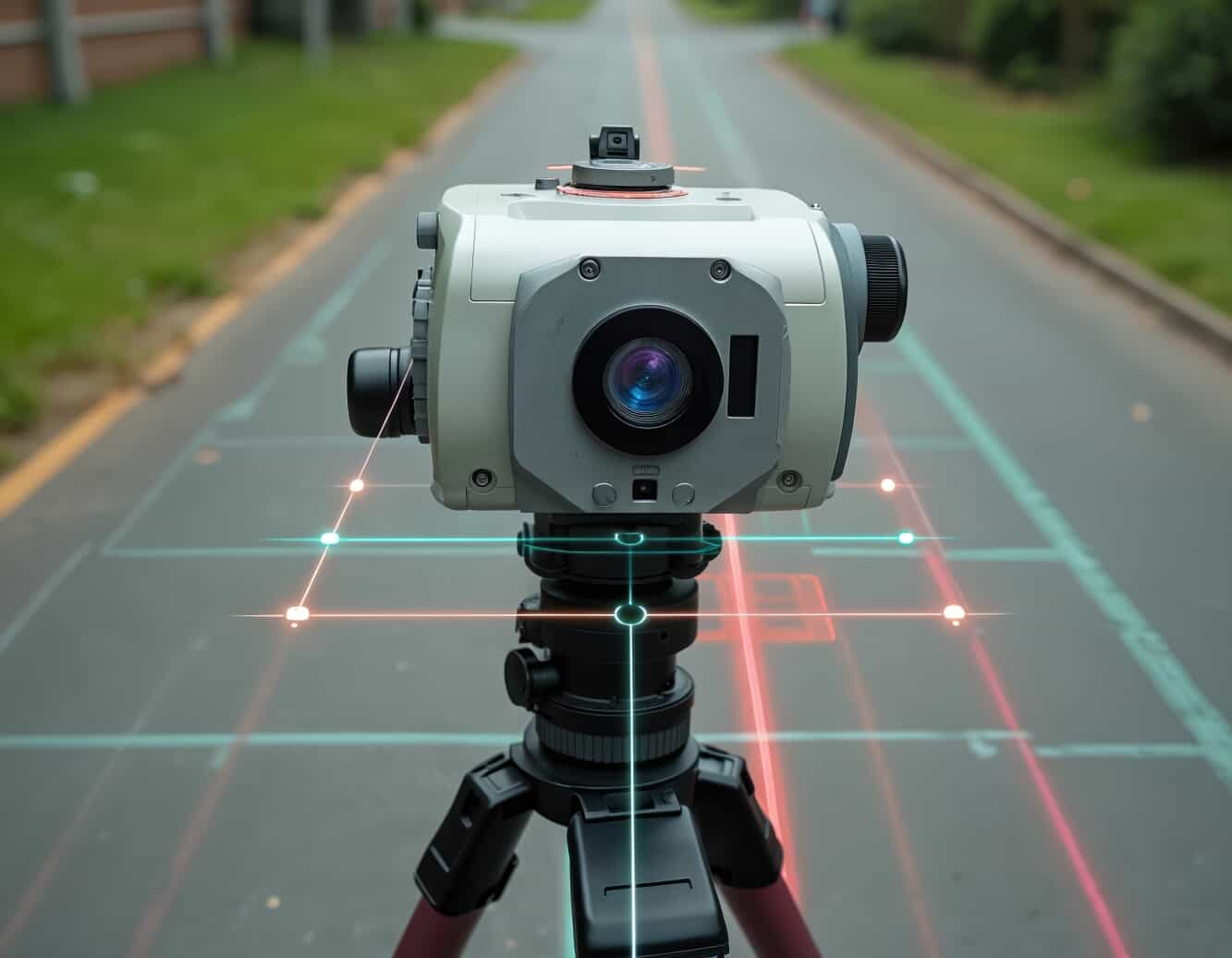
In the world of modern land surveying, construction, and geospatial analysis, precision and speed are non-negotiable. That’s why 3D laser scanning has become a cornerstone technology for professionals seeking accurate, high-resolution spatial data. Whether you’re mapping terrain, documenting infrastructure, or modeling complex environments, a reliable laser scanner can dramatically improve your workflow and data integrity.
Trimble, a recognized global leader in geospatial innovation, offers a range of 3D laser scanning systems designed to meet diverse project needs, from high-precision engineering to rapid field capture. But with several Trimble scanners available, each with distinct capabilities, how do you choose the right one for your specific use case?
In this article, we’ll compare Trimble’s leading 3D laser scanners — X7, TX8, X9, X12, and SX12 — to help you understand which model fits best based on your technical requirements, project scope, and budget. We’ll look at key performance metrics, practical applications, and real-world usability so you can make an informed decision.
For a general overview of Trimble’s 3D scanning technology, visit: Trimble 3D Scanning Overview
Why Compare Trimble 3D Laser Scanners?
Each Trimble scanner is built to serve a specific niche. Some excel in portability and ease of use, others in range and accuracy. Choosing the wrong scanner for your environment can lead to inefficiencies, increased costs, or even inaccurate results.
Here are the core criteria professionals typically consider:
- Accuracy & Precision: How closely does the scan reflect the true dimensions of the object or terrain?
- Range & Speed: Can it scan large areas, or is it optimized for detailed close-range work?
- Portability & Ease of Use: Is it suitable for solo fieldwork? Does it require extensive setup?
- Durability: Can it withstand harsh environmental conditions?
- Software Integration: Does it integrate with existing software or require proprietary platforms?
- Cost Efficiency: Is the investment justifiable for your project’s scale and frequency?
- Workflow Compatibility: How well does the scanner integrate into your current data collection, processing, and sharing pipeline? Seamless transition from field to office can be a critical determinant in overall ROI.
- Support & Training Resources: For teams adopting new technology, Trimble’s global support network and extensive training options might be a deciding factor. This is especially important for smaller firms or educational institutions that may not have in-house technical staff.
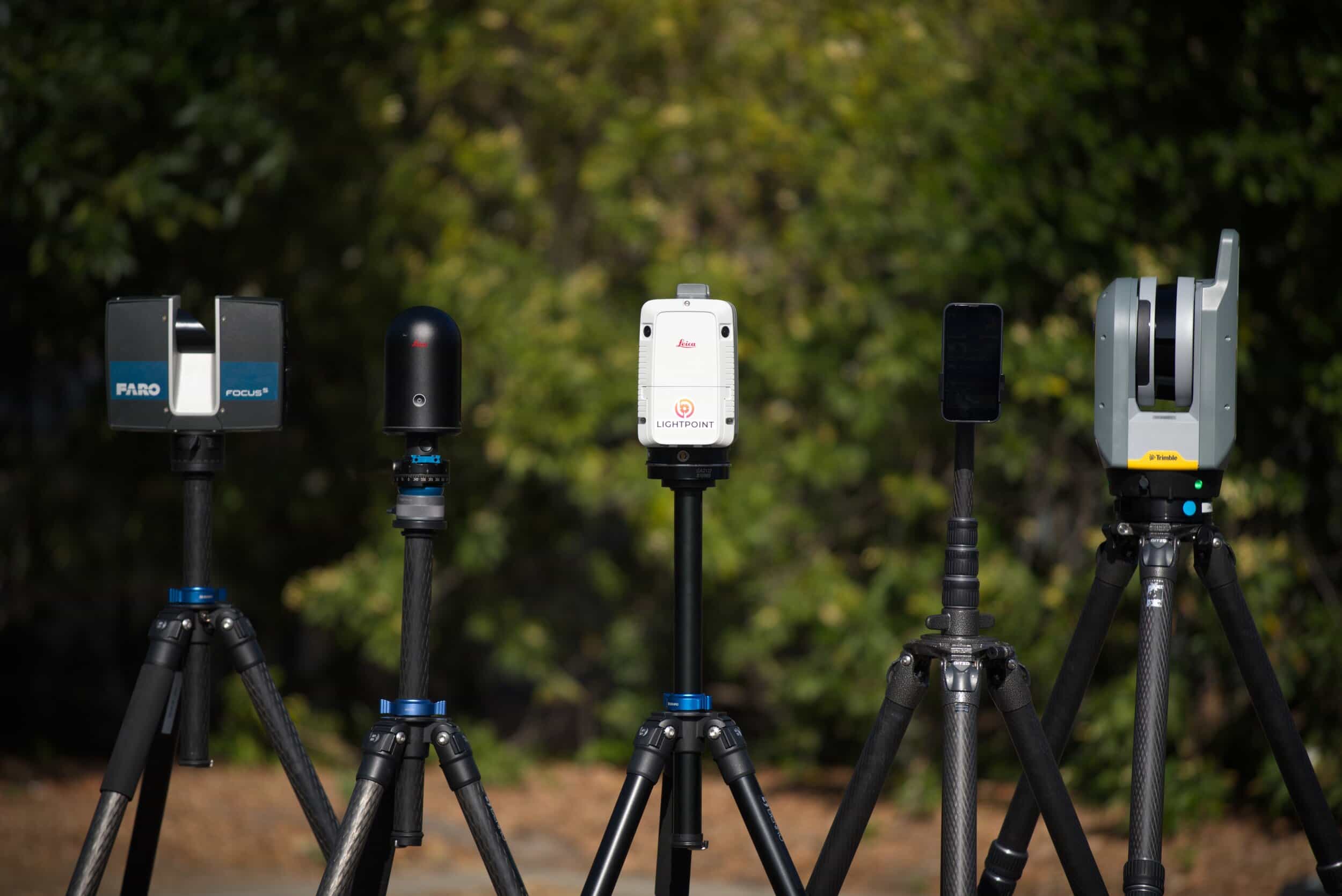
Overview of Leading Trimble 3D Laser Scanning Systems
Let’s explore Trimble’s current flagship models and how they stack up.
1. Trimble X7
The Trimble X7 is a compact, fully integrated 3D laser scanning system aimed at professionals who prioritize simplicity, accuracy, and reliability in the field. Designed for automatic calibration and fast setups, it’s ideal for construction, forensics, and building documentation.
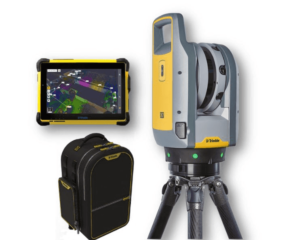
Key Features:
- Auto-calibration and self-leveling
- 2-minute startup with real-time registration
- IP55-rated for dust and water resistance
- Integrated with Trimble Perspective software
Best For:
- Medium-range projects
- Construction verification
- Civil and architectural documentation
Bonus Benefit: The X7 is also widely used in educational settings due to its intuitive UI, making it ideal for training the next generation of surveyors and engineers. Universities and vocational institutions often include the X7 in lab programs to teach scan-to-BIM workflows.
2. Trimble TX8
The Trimble TX8 is Trimble’s high-speed, high-range laser scanner, offering a robust solution for urban, industrial, and large-scale projects where efficiency and accuracy are essential.
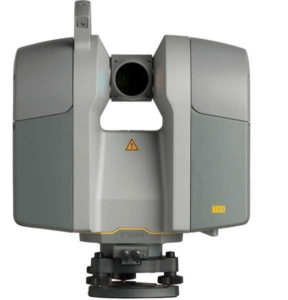
Key Features:
- Captures at 1 million points per second, reducing field time significantly.
- Standard 120 m reach, extendable to 340 m with an optional upgrade.
- Integrated 10 MP HDR camera for high-quality, colorized scans.
- Intuitive touchscreen with WLAN control for Windows, iOS, and Android devices.
- Seamlessly works with Trimble RealWorks software to handle large datasets and export to CAD or BIM platforms.
Best For:
- Civil engineering and infrastructure
- Plant, mining, and industrial site surveying
- Urban mapping, heritage preservation, and forensics
- High-density BIM and quality-control workflows
Performance Highlights: This model achieves <2 mm accuracy at 120 m, with a high-precision mode (<1 mm accuracy at ≤80 m) in ~3 minutes per scan. It comes with an optional extended-range upgrade that increases reach while maintaining reliable precision.
3. Trimble X9
The Trimble X9 builds on the X7’s ease of use with enhanced speed, accuracy, and extended range, making it ideal for demanding outdoor environments and high-volume scanning.
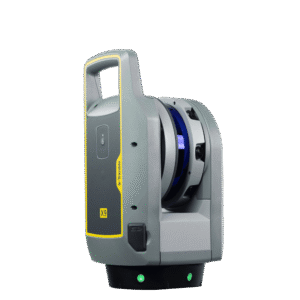
Key Features:
- High-speed scanning (up to 1 million points/sec)
- Up to 150m range with improved accuracy
- Enhanced environmental resistance (IP65 rating)
- Seamless compatibility with Trimble RealWorks and Perspective
Best For:
- Large-scale construction and infrastructure projects
- Industrial site capture
- Surveying in extreme environments
Workflow Highlight: Many firms pair the X9 with drone photogrammetry for a hybrid data capture approach, using the laser scanner for critical hard surfaces and drone imagery for surrounding context. Trimble’s ecosystem supports this integrated method via Trimble Business Center.
4. Trimble X12
The X12 is Trimble’s high-performance scanning system based on the proven Z+F 5010X platform, tailored for engineering-grade precision and long-range applications.
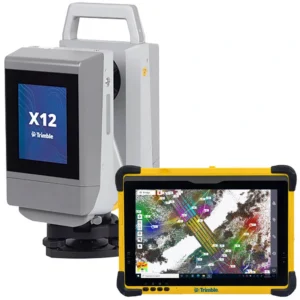
Key Features:
- Extremely high point density (up to 1.2 million points/sec)
- Ranges up to 365m
- Advanced onboard camera and imaging
- Flexible mounting options
Best For:
- Heritage documentation
- Mining, oil and gas, and large industrial sites
- Projects requiring photorealistic output
Use Case Insight: When documenting historical structures, where minimal surface disruption is essential, the X12’s high fidelity and imaging accuracy are ideal. Preservationists often cite it as a top tool for non-invasive cultural heritage documentation.
5. Trimble SX12
A hybrid system, the Trimble SX12 combines high-speed scanning with total station functionality, offering both surveying and 3D scanning in a single instrument.
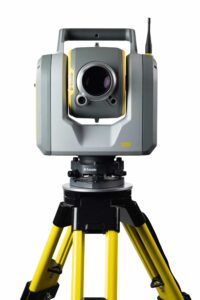
Key Features:
- Full total station functionality
- High-accuracy scanning up to 600m
- Vivid, precision laser pointer for targeting
- Streamlined field workflow with Trimble Access
Best For:
- Surveyors who need both scanning and precise point measurement
- Complex boundary and topographic projects
- Utility and transportation infrastructure
Field Flexibility: The SX12 can be especially valuable in constrained sites, such as urban alleys, bridges, or utility corridors, where switching between point-based survey and full scans can save hours of setup time.
Technical Specifications and Performance Comparison
Model | Max Range | Scan Speed | Accuracy | Weight | Protection Rating | Software Integration |
X7 | 80 m | 500,000 pts/sec | ±2 mm @ 10 m | 5.8 kg | IP55 | Trimble Perspective |
TX8 | 120 m | 1 M pts/sec | <2 mm @ 120 m | ~11 kg | IP54 | Industrial, urban, BIM |
X9 | 150 m | 1,000,000 pts/sec | ±1.5 mm @ 10 m | ~6 kg | IP65 | Perspective, RealWorks |
X12 | 365 m | 1,200,000 pts/sec | ±1 mm @ 10 m | 5.7 kg | IP54 | RealWorks, Perspective |
SX12 | 600 m (scan) | 26,600 pts/sec | ±1.5 mm (scan), ±1” (survey) | 6.2 kg | IP55 | Trimble Access, TBC |
Did You Know? While scan speed matters, scan efficiency (how much usable data you collect per minute) depends on resolution, overlap, and field conditions. Trimble’s auto-registration capabilities help maximize data utility with free manual interventions.
Pros and Cons of Trimble 3D Laser Scanning Systems
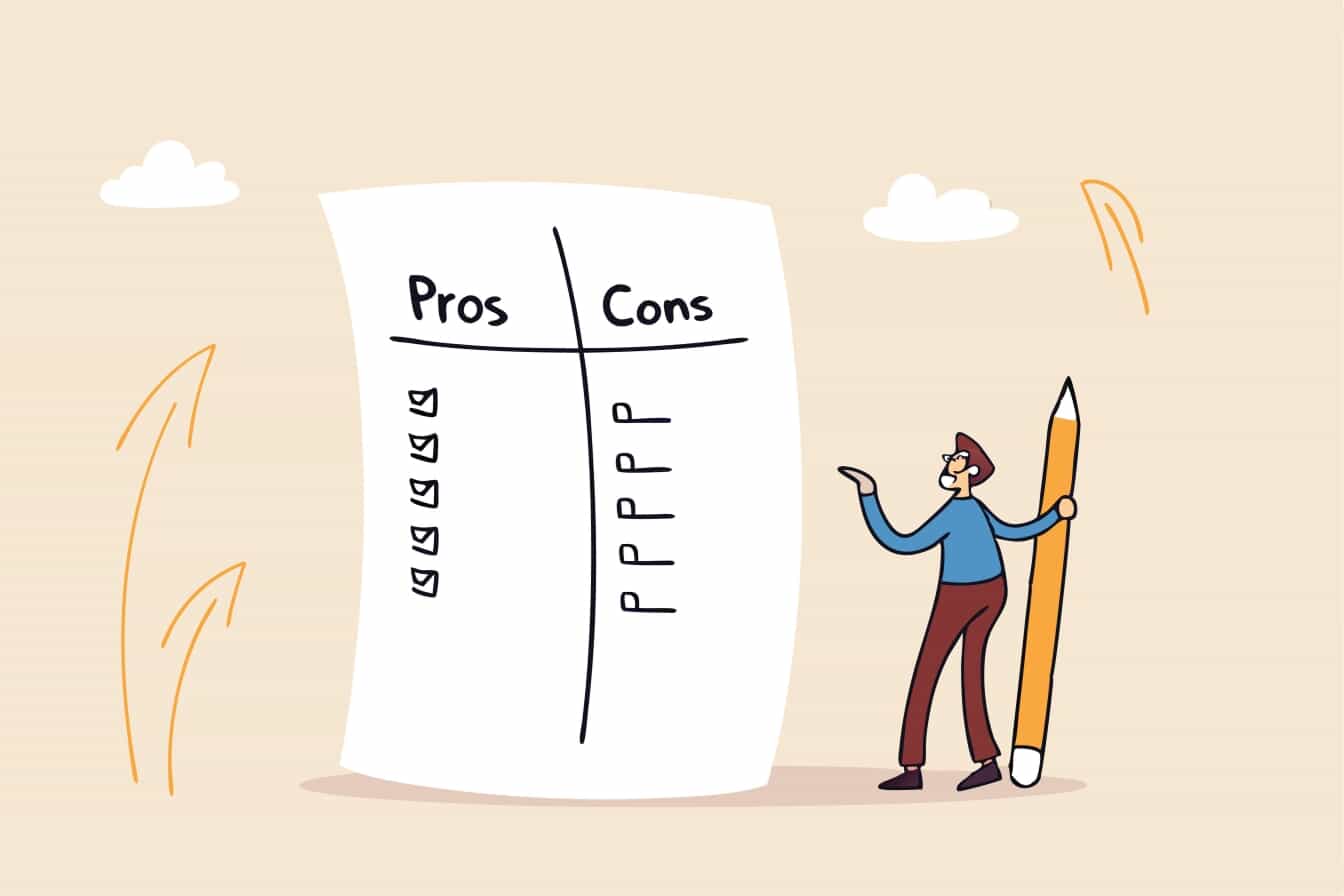
Here’s a quick breakdown of the major strengths and considerations for each model:
Trimble X7
- Easy to use, fast setup, automatic calibration
- Affordable entry point for high-precision scanning
- Limited range for large-scale terrain projects
Trimble TX8
- Superb scan speed and range; HDR imaging; perfect for high-density, large-area projects
- Heavier (~11 kg); IP54 rating offers less environmental protection than X9/SX12; requires strong field computing capacity
Trimble X9
- High speed and range with field-ready durability
- Ideal for large outdoor projects
- Higher cost than X7
Trimble X12
- Exceptional detail and photorealistic output
- Extended range suitable for industrial-scale sites
- Heavier data output, requires powerful processing tools
Trimble SX12
- Dual-purpose functionality (survey + scan)
- Precision measurements for hybrid workflows
- Slower scan speed compared to dedicated laser scanners
Model | Pros | Considerations |
X7 | Lightweight, easy setup, cost-efficient | Shorter range |
TX8 | Fast scans, long range, HDR imaging | Heavier unit, lower IP rating |
X9 | High range, rugged build, fast scans | More expensive |
X12 | Superior detail, extended range, image capture | Larger files, more processing time |
SX12 | Total station + scanner combo, versatile | Slower scanning, more complex workflow |
Application Scenarios & Industry Use Cases
Each Trimble scanner fits distinct environments. Here’s how you might apply them:
- Construction & Civil Engineering: Use the X7 or X9 for rapid, reliable construction verification and earthworks analysis.
- Heritage & Forensics: The X12 offers the accuracy and imaging resolution needed for preserving heritage sites or documenting crime scenes.
- Land Surveying & Topography: The SX12 is a favorite among surveyors needing both high-accuracy measurements and 3D scanning capabilities in one.
- Industrial & Environmental Monitoring: For large-scale industrial or environmental projects, the TX8, X9, and X12 deliver long-range capture and detailed imaging.
- Urban Infrastructure & Plant Documentation: The TX8 excels in high-efficiency scanning of complex urban corridors, processing plants, and other dense environments where scan speed and range are critical.
- Education & Training: Universities and technical institutes frequently use Trimble scanners like the X7 and SX12 to teach scan-to-BIM, GIS workflows, and geospatial analysis. Their intuitive interfaces make them ideal for classroom and field-based instruction.
User Feedback and Expert Insights
Surveying professionals consistently highlight the Trimble X7 for its ease of use and reliability in day-to-day fieldwork. The X9 earns praise for rugged performance under challenging environmental conditions. Experts appreciate the X12’s unmatched image fidelity, especially when documentation or visualization is crucial. Users of the SX12 often cite its versatility as a deciding factor — especially in complex surveys where both scanning and total station data are required. The TX8 has also received strong marks from field users, particularly for its range, speed, and accuracy.
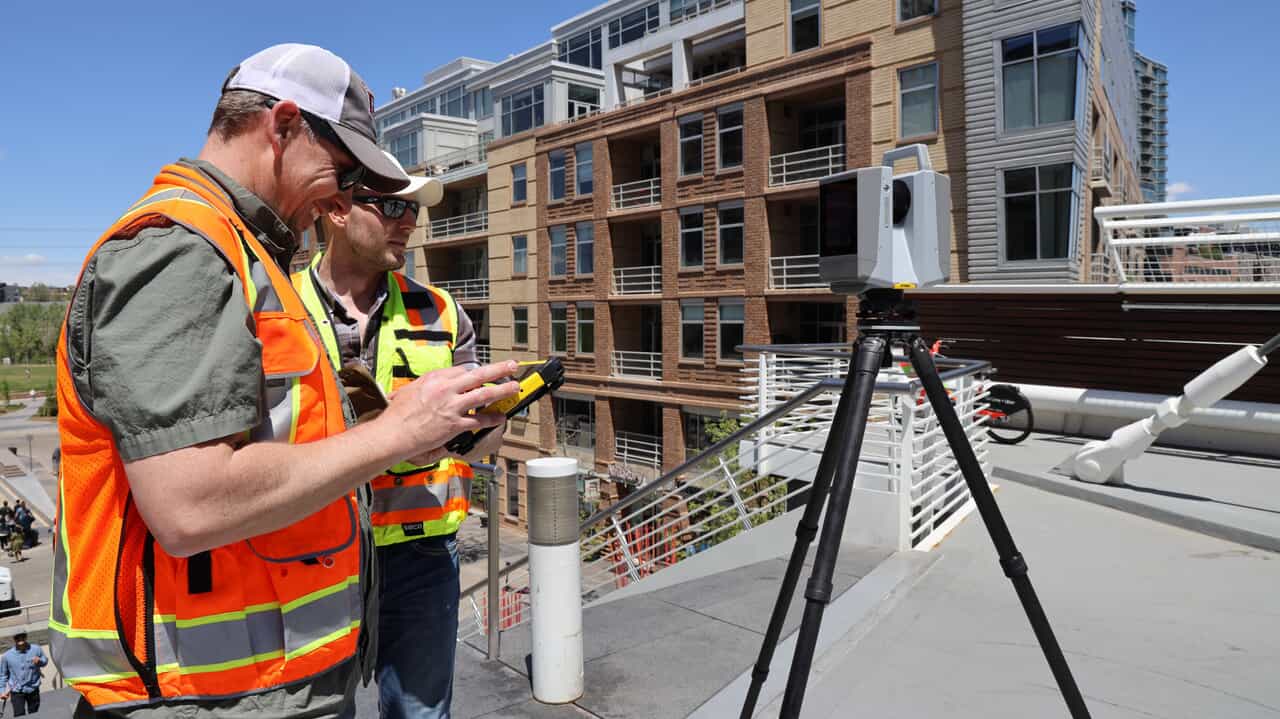
Model Specific Feedback
Trimble X7
Forum users often praise the X7’s ease of use and registration capabilities:
Another user notes: “Survey grade leveling… really eliminate most of the drift.”
Trimble X9
Industry sources and users highlight the X9’s hardware innovations, including “longer scanning range, higher accuracy, shorter scan times, and ‘exceptional’ sensitivity,”
One Facebook user commented: “We acquired an X9 a few months ago and the results have been great so far!”
Trimble X12
Professionals value the X12’s detailed data and imagery:
Trimble literature also backs its precision: “Sub‑millimetre accuracy … was a game changer” for specialist measurement consultants.
Trimble TX8
The TX8 earns praise for the balance of speed and range. A French case study involving a renovation scanner deployment praised the TX8 for offering “the perfect combination of speed, range, and precision to quickly capture precise 3D spatial data.”
Trimble SX12
Reddit users appreciate its combined capabilities:
GeoWeek offers similar commentary:
The SX12 allows surveyors to use “the same workflows from a robotic total station, but also the high-end 3D laser scanning and imagery.”
Why It Matters
When selecting a 3D laser scanner, technical specifications only tell part of the story. Hearing from professionals who use these systems daily adds essential context. Real-world feedback reinforces what makes each Trimble scanner distinct — and helps you match the right model to your workflow:
- Trimble X7 stands out for its fast setup, reliable auto-calibration, and ease of use, especially in building surveys and education settings.
- Trimble X9 offers enhanced durability and scanning range, making it ideal for civil and infrastructure projects in variable outdoor conditions.
- Trimble X12 earns praise for its clean, high-density point clouds and photorealistic imagery, valuable for heritage, industrial, and detailed modeling work.
- Trimble TX8 is favored for speed and range in large-scale or urban environments, but requires consideration for its weight and IP54 rating.
- Trimble SX12 bridges survey and scanning workflows, enabling crews to capture high-accuracy geospatial data with a single hybrid instrument.
Together, these insights help you make a confident, informed decision, not just based on specs, but on how these systems perform in the field, under real-world conditions.
How to Choose the Right Trimble Laser Scanner
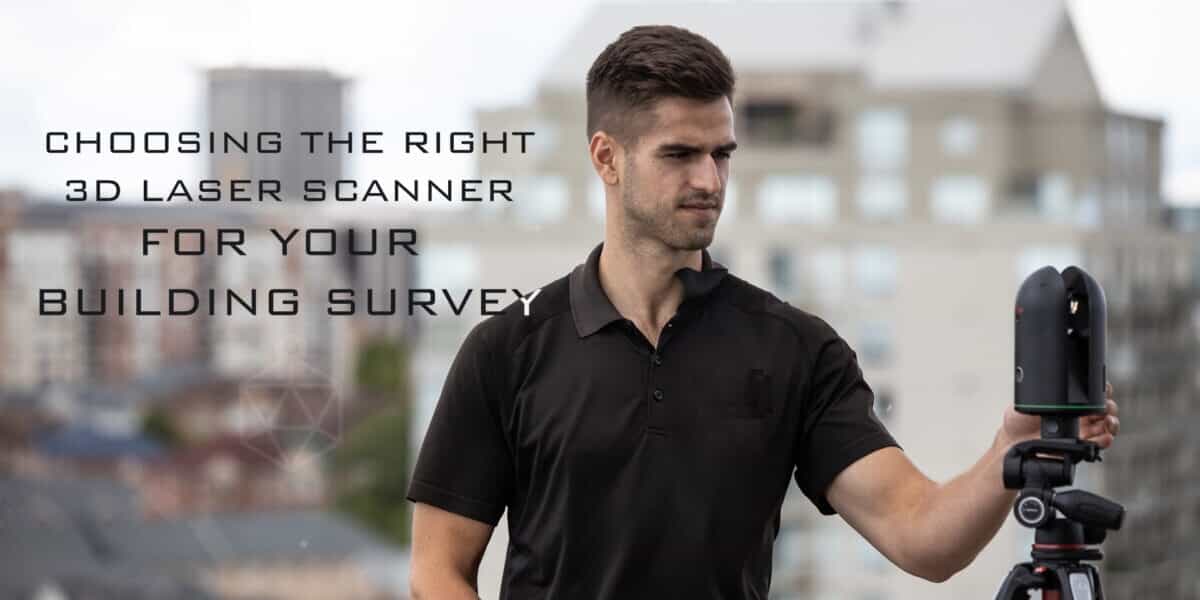
Here’s a simple decision framework to help narrow down your choice:
Define Your Project Environment
- Indoors, short-range: X7
- Outdoor terrain, long-range: X9 or X12
- Urban/industrial sites with large scan areas: TX8
- Hybrid survey + scanning: SX12
Assess Accuracy Requirements
- Architectural documentation +/- 2 mm is sufficient: X7
- Engineering-grade models: Look for +/- 1 mm: X12 or TX8
Consider Workflow & Crew Size
- Solo operators might benefit from the X7’s fast setup and auto-calibration.
- Teams on complex jobsites might prefer the TX8, SX12 or X9 for versatility and range.
- Teams needing survey control + scan data: SX12 combines both in one instrument
Evaluate Budget vs. ROI
- Entry-level precision:
- Long-term industrial-grade performance: TX8, X9 or X12
- Multi-purpose investment: SX12
Pro-Tip: Think Long-Term
If your scanning needs are evolving, choose a model that scales with your capabilities. For example, teams planning to adopt BIM, digital twins, or asset lifestyle management may benefit from the higher imaging quality and software compatibility of the X12.
Conclusions and Recommendations
Trimble’s 3D laser scanning systems offer powerful options for virtually every surveying and geospatial need. Whether you’re focused on speed, accuracy, or hybrid functionality, there’s a model tailored to your workflow.
- Choose the X7 for fast, user-friendly scanning on small to mid-sized projects.
- Select the TX8 for large-scale industrial or urban scanning where speed and range are critical.
- Go with the X9 for rugged environments and long-range efficiency.
- Opt for the X12 when ultra-high resolution and photorealism are required.
- Use the SX12 if your team needs both scanning and total station capabilities in one package.
Ready to Find the Perfect Fit?
Choosing the best 3D laser scanning system depends on your project goals, terrain conditions, data needs, and long-term workflow. Whether you’re focused on construction verification, heritage documentation, industrial modeling, or hybrid survey applications, Trimble has a scanner that fits.
Explore Our Trimble Laser Scanner Range
Compare models side-by-side by features, scan speed, accuracy, and software compatibility.
Learn More About Trimble 3D Scanning
Get detailed insights into Trimble’s scanning technology, field workflows, and integration options.
How to Increase Productivity with a Trimble Laser Scanner
Still Deciding?
Our team can help evaluate your project requirements and recommend the best-fit Trimble system for your needs.
Contact Us for Expert Guidance
Internal Reference Link: Trimble Guidance Systems